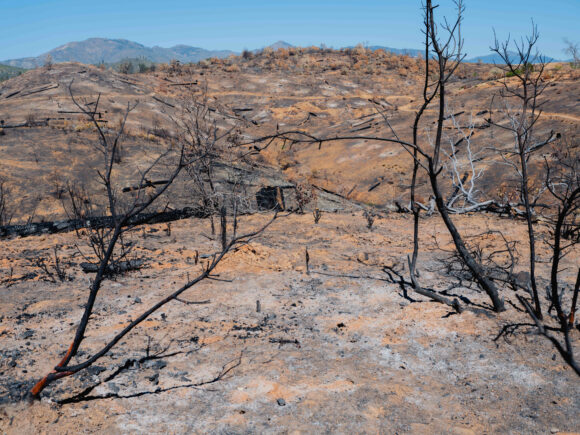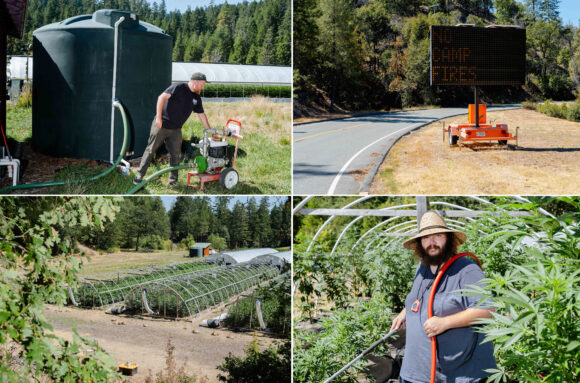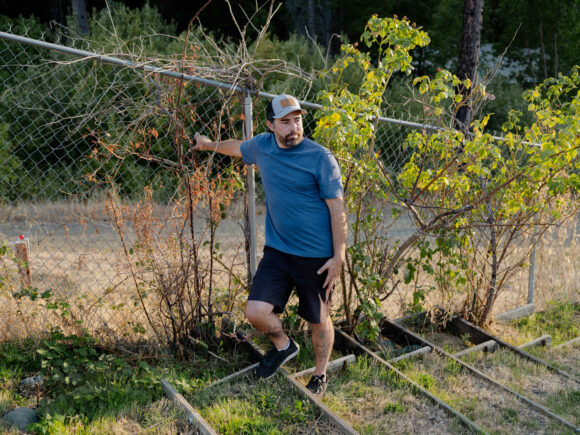Hannah Whyte is one of thousands of Californians who have struggled to insure their property in the event of wildfire.
Her 77-acre farm nestled deep in a wildfire-vulnerable forest lost its coverage from State Farm after the mountainous region burned six years ago, and she’s found herself excluded from the state-created insurer of last resort designed to protect the most vulnerable. She’s become uninsurable because of her crop: cannabis.
Whyte’s plight is becoming increasingly common for weed farmers in the Emerald Triangle, which includes Humboldt, Mendocino, and Trinity Counties, and has long been the epicenter of US cannabis cultivation. California legalized marijuana for recreational use in 2016, but growers fueling the state’s $5 billion industry already struggle to find insurance given the federal ban on their crop.
With major insurers pulling back from California because of wildfire risk, pot farmers increasingly find themselves confronting the risk of catastrophe on their own. Whyte said she’s relying on “water pumps and a strong dose of bravery” to protect her home and farm, which produces up to 1,600 pounds of marijuana annually. (State Farm didn’t respond to requests for comment.)
“It leaves cultivators and homestead rural businesses at serious risk,” Whyte, 38, added, while walking between the rows of spiky green cannabis plants on her farm one recent afternoon.

Propelled by hot, dry and gusty conditions, California’s fire season is in full swing. This year, wildfires have scorched nearly 1 million acres, led to hundreds of thousands of evacuations, and destroyed more than 1,500 structures across the state. Firefighters are still battling three massive blazes in Southern California near Los Angeles. While temperatures are starting to cool, the threat of wildfires will continue into late fall for much of California. That leaves homeowners in wildfire-prone areas on edge, but the concerns are particularly acute for growers with homestead farms.
Legal marijuana cultivators are ineligible for the state-created FAIR plan, which provides coverage for customers who can’t find it elsewhere. An underwriting guideline prohibits any “‘illegal activity that increases risk to a property” that “presents an unacceptable hazard.” A spokesperson for the FAIR plan said insurers risk having no legal protection for violating federal law by covering properties involved in the marijuana business.
That’s left many small growers to contend with two risky options: forgo insurance or hide their business from the state-backed insurer. The latter carries substantial risk that could lead to a lawsuit or coverage loss. What’s emerging is a crisis for a multibillion-dollar industry that’s already struggling to stay afloat in the top pot-producing state.
“I’m surprised the FAIR plan is not writing insurance for properties where cannabis is being legally grown,” said former insurance commissioner Dave Jones. “The clear policy of the insurance commissioner and Department of Insurance is that there should be insurance for the cannabis industry.”
The FAIR plan’s underwriting guidelines must be approved by the insurance commissioner, which means that person has the authority to overturn the plan’s rules prohibiting coverage of properties with cannabis, Jones said.
Michael Soller, a spokesperson at the Department of Insurance, declined to comment on the commissioner’s authority to change the FAIR plan’s underwriting guidelines. He said that Insurance Commissioner Ricardo Lara “has taken numerous steps to improve cannabis coverage,” including sponsoring a 2022 state law that ensures it is not a crime for companies to provide insurance to people in the commercial cannabis industry.

“This is not simple or easy as it’s being portrayed,” Soller said in an emailed statement. “If so it would have been done years ago.”
Risky Business of Predicting Where Climate Disaster Will Hit
The FAIR plan’s risk exposure has approached $400 billion as of June 30, up nearly 40% in the past year. Despite the strain, Lara in July announced a deal to extend coverage to higher-value properties.
“It’s enough of a situation where he can get away with not mandating it for cannabis,” Karl Susman, an insurance agency owner based in Los Angeles, said. “The amount of money that the FAIR plan has versus their total exposure in California is horrific.”
Most cannabis is grown on small family-owned farms. But over the years, legacy growers have been hit with competition from organized crime, high operating costs, the declining price per pound of wholesale cannabis and the state’s onerous web of regulations. Larger corporate growers have entered the market with more resources to lower costs and expand operations, squeezing out small farmers. There are about 5,000 active cultivation licenses in California as of September, roughly half of which are in the Emerald Triangle, according to the state’s Department of Cannabis Control.
Those troubles are now being exacerbated by California’s property insurance crisis. Cannabis is more prone to wildfire risk than any other crop grown in the state, according to a study from the University of California Berkeley’s Cannabis Research Center. Wildfires and smoke exposure in 2020 and 2021 alone caused $2.4 billion in damages.
“Wildfire risk is unique to cannabis as a crop, not because of some inherent quality of its cultivation but because of policy decisions around land use and where farms are allowed to be sited,” said Michael Polson, director at UC Berkeley’s Cannabis Research Center.
Securing insurance for commercial cannabis is already no easy task. Many of the largest providers will not work with the industry because marijuana remains illegal federally. Insurance costs for cannabis growers are higher; farms are situated in areas that many major companies consider to be too risky; and insurers that offer coverage often want to sell more comprehensive policies than fire insurance alone, Susman said.
“You’ve got basically a three-edged sword against farmers that are in this industry,” he said.

Jacob Soutsos and his family live on 28 acres tucked in the wooded hills overlooking a river in Trinity County. He began cultivating cannabis four years ago with the aim of becoming a full-time grower. But a lengthy and costly legal battle with the FAIR plan — his parents’ former home insurer — forced him to give up that dream.
Soutsos’ parents received a partial claim to rebuild their home ravaged by fire in 2017 before the insurer began investigating Soutsos’ cannabis operations, which he grew in a separate building not covered by the FAIR plan on the property. The discovery led the FAIR plan to drop his parents’ coverage for allegedly violating the terms of their policy, surprising Soutsos who said he was unaware that his licensed business could jeopardize their insurance.
After a years-long lawsuit, Soutsos’ parents eventually settled out of court, but they had to file for bankruptcy after putting their savings towards the remaining construction costs of the home. Even then, they were only able to afford to build a small accessible dwelling unit, downsizing from their five-bedroom home. In the hopes they will have an easier time finding a policy, Soutsos has closed his cannabis business. He is now looking for work, though he’s struggled to find a steady, full-time job in his area, which is facing a shrinking job market.
“I stopped cultivating. I’m not going to pursue this anymore,” Soutsos, 36, said. “I’m trying to protect our property and livelihood instead of trying to pursue my business endeavors.”
Soutsos’ experience serves as a cautionary tale that’s led other legally compliant farmers in the area to hide their activities from the FAIR plan. One Trinity County farmer insured by the FAIR plan, who withheld his name because growing cannabis violates the terms of his policy, said he had a roof leak earlier this year that he paid out of pocket for rather than filing a claim to avoid being discovered. The thought of not having coverage weighs heavily on him since his mortgage depends on it: Lenders require homeowners to maintain property insurance to avoid foreclosure or losing their home.
“I hate to say this, but we’re probably committing some kind of fraud with our insurance,” he said. “My strategy as far as insurance and mortgage goes is to just pay it and keep my head down. If a fire burns my house down, I fully expect to get nothing. In fact, we wouldn’t even file a claim and risk them suing us.”
The FAIR plan would not disclose the specific hazards that cannabis cultivation poses. But insurers often deny coverage based on potential chemical exposure, fire and increased crime risks, according to Aaron Pelley, an attorney at the law firm Harris Sliwoski who has represented cannabis growers in California, Oregon and Washington state for more than 17 years.
Some of those concerns are legitimate, he said while arguing growing cannabis isn’t riskier than other crops. “Insurers are going to continue to do what benefits them,” Pelley said. “They want to collect as much money as possible with the least amount of risk, even though they’re in the industry of risk.”
For now, growers like Whyte are preparing for the worst amid this year’s fire season. She’s stocked up on water, cleared vegetation and created a buffer of defensible space around the property. In the days before legalization, it was advantageous for cannabis farmers to hide out in the remote areas of the forest to avoid the authorities, Whyte said. But today, it’s presented an unforeseen risk that’s made them vulnerable to a new kind of danger.
“We just can’t leave,” she said. “It’s really just on us to do the work to keep us safe.”
Top photo: Hannah Whyte at her cannabis farm in Willow Creek, California. Photographer: Jonah Reenders/Bloomberg.
Topics California Catastrophe Natural Disasters Wildfire Cannabis
Was this article valuable?
Here are more articles you may enjoy.


 Sentry Buys Nonstandard Auto Insurer The General From American Family for $1.7B
Sentry Buys Nonstandard Auto Insurer The General From American Family for $1.7B  California Policyholders May Be On the Hook for Wildfire Losses
California Policyholders May Be On the Hook for Wildfire Losses  US Property Insurance Rates Fall for First Time Since 2017
US Property Insurance Rates Fall for First Time Since 2017  Francine Estimated to Cause $9B in Damage With $1.5B in Insured Losses
Francine Estimated to Cause $9B in Damage With $1.5B in Insured Losses 

